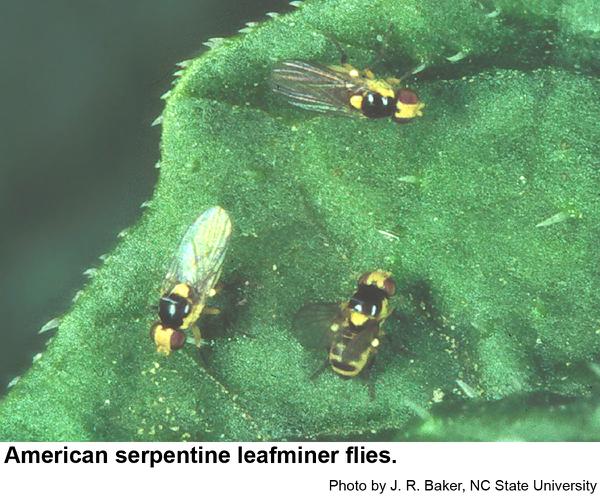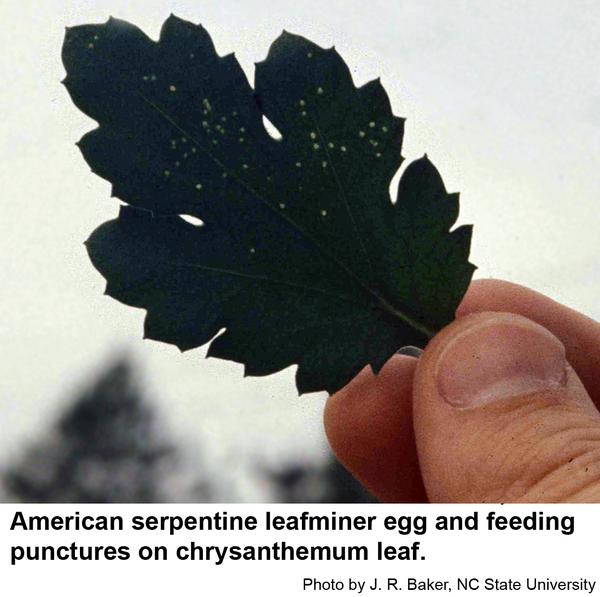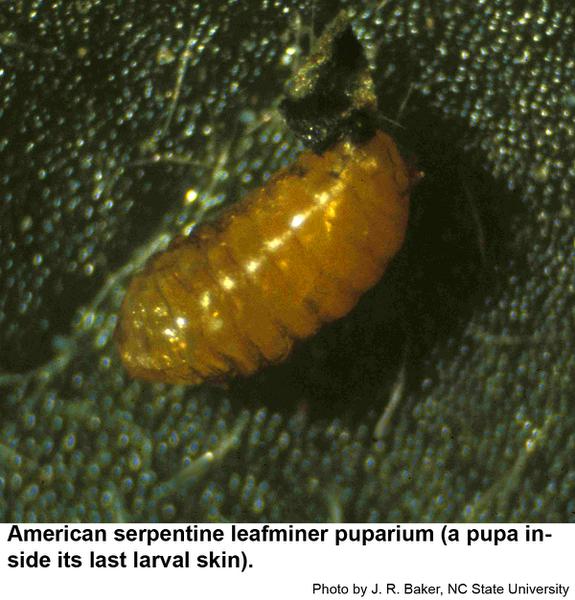Description and Biology
The American serpentine leafminer, Liriomyza trifolii, is a small (3/32 inch), dark gray fly with yellow markings. Females puncture the leaf surface causing the cell contents to pool. Males and females then suck out the exposed "juice." Females insert tiny, white eggs into leaves. Females live can live three to four weeks and may lay some 200 to 400 eggs over their life time. Tiny maggots hatch and tunnel through the leaf making a serpentine mine. The maggots are white to yellow and are visible through the leaf epidermis as they grow. Maggots finally molt into a pupal stage that is seed-like and light brown. An new generation of leafminer flies emerges from the pupal skin and through the upper leaf surface. In hot weather, a complete generation takes about two weeks. Outdoors, we have at least three or four complete generations each year in North Carolina.
Host Plants
The American serpentine leafminer infests many plants. Some hosts are aster, baby's breath, chrysanthemum, dahlia, daisy, marigold, mistflower, petunia, sunflower, and zinnia as well as vegetables such as beans, cantaloupe, carrot, celery, cucumber, eggplant, lettuce, onion, peas, and potato. Weeds such as nightshade, Bidens, and pilewort are also infested.
Residential Recommendations
American serpentine leafminers are plagued with tiny parasitic wasps in three families. Should they be noticed in chrysanthemums and other herbaceous ornamentals, probably the best thing to do is ignore them and let the parasites take care of the leafminers. If a pesticide must be applied, try a systemic insecticide such as imidacloprid (available in most big box stores). Pyrethroid insecticides will only encourage these leafminers by eliminating their parasites.
References
- Insect and related Pests of Flowers and Foliage Plants. Baker, J. R., ed. 1994. N.C. Cooperative Extension. AG-136. 106 pp.
- Common name: American serpentine leafminer, scientific name: Liriomyza trifolii (Burgess) (Insecta: Diptera: Agromyzidae). Capinera, J. L. 2017 (revised). Featured Creatures. Entomology & Nematology, FDACS/DPI, EDIS. Publication Number: EENY-254.
- Liriomyza trifolii (Burgess in Comstock, 1880). Ellis, W. N. 2021. Plant Parasites of Europe, leafminers, galls and fungi.
- NC State Extension Plant Pathology Publications
- NC State Extension Horticultural Science Publications
- North Carolina Agricultural Chemicals Manual
For assistance with a specific problem, contact your local Cooperative Extension center.
This Factsheet has not been peer reviewed.
Publication date: Dec. 29, 2017
Reviewed/Revised: Oct. 7, 2022
Recommendations for the use of agricultural chemicals are included in this publication as a convenience to the reader. The use of brand names and any mention or listing of commercial products or services in this publication does not imply endorsement by NC State University or N.C. A&T State University nor discrimination against similar products or services not mentioned. Individuals who use agricultural chemicals are responsible for ensuring that the intended use complies with current regulations and conforms to the product label. Be sure to obtain current information about usage regulations and examine a current product label before applying any chemical. For assistance, contact your local N.C. Cooperative Extension county center.
N.C. Cooperative Extension prohibits discrimination and harassment regardless of age, color, disability, family and marital status, gender identity, national origin, political beliefs, race, religion, sex (including pregnancy), sexual orientation and veteran status.




